
 Accessorize your
Beacon or industrial size Crackle Tube with this rugged pygmy radio tower !
Accessorize your
Beacon or industrial size Crackle Tube with this rugged pygmy radio tower !This project started out as an idea for a pool table light but ended up like this as I was trying to find a little radio tower to hold up a newly acquired radio tower beacon. Too bad I already have a que stick rack...
It's made by Rohn (www.rohnnet.com). It is a 5 foot short tower section of 45G tower truss capped on each end by beacon plates. The tower without the beacon stands about 66 1/4 inches tall on a 22 inch per side triangular base. The base sits on the floor cushioned by three 3 1/4 inch diameter non-marring bumpers.
The tower truss and beacon plates are supplied with a hot dipped galvanized steel finish. I filed the slag balls off it and then had the tower truss powder coated white. I had the beacon plates coated in the traditional aviation orange.
The beacon shown is a used Hughey & Philips KG-114 that I got on ebay. This 'medium' intensity FAA L-864 designated obstruction light contains not one but two 620 watt incandescent bulbs. One of the greatest features of this little tower is that it (mercifully) puts the brightest portion of the beacon's output just above eye level.
With the beacon on, the tip is about 8 feet 4 inches from floor level. Note that this is
![]() taller than a standard 8 ft ceiling, so if you
have or get one of these KG-114 beacons you'll need to put the whole thing in a room with a high ceiling.
taller than a standard 8 ft ceiling, so if you
have or get one of these KG-114 beacons you'll need to put the whole thing in a room with a high ceiling.
Four 5/8" bolts secure the beacon onto the tower top. The beacon plugs into the tower using a twist-lock connector and receptacle so it can be easily installed and removed.
The beacon version shown has clear glass lenses with removable red color filters. The more common version (seen on radio towers throughout the America's) has solid red lenses and therefore doesn't need filters. A disadvantage of the clear lens / red filtered version is that some white light still gets through at the top and bottom. With a solid red lens version, only red comes through. For more beacon info check out http://airportsystems.honeywell.com/oblighting/products/kg114/.
An advantage of the clear glass version is that the color filters can be removed. In the picture the clear lensed beacon's red filters are out, leaving plain white light. This light bouncing off the ceiling and walls easily lights up the whole room. The lamps are shown running at about half voltage so they don't overwhelm the camera (voltage drop feat being performed by that variac visible down in the bottom left corner of the picture). At full power, the beacon more than lights up the room - it heats it !
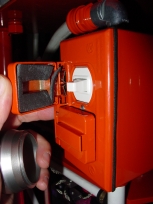 Also available
in lieu of the KG-114 shown are newer beacons which use LED's, or a combination of LED's and a xenon strobe. These use about
90% less electricity and are shorter, so they might fit on this tower under a normal height ceiling. Or, you can forgo the beacon altogether and
just have a neat crackle tube display that'll fit in a normal room.
Also available
in lieu of the KG-114 shown are newer beacons which use LED's, or a combination of LED's and a xenon strobe. These use about
90% less electricity and are shorter, so they might fit on this tower under a normal height ceiling. Or, you can forgo the beacon altogether and
just have a neat crackle tube display that'll fit in a normal room.
I haven't built a blinker/dimmer for the beacon (yet). Just have a duplex switch to control each lamp individually. This switch pair is located in the orange junction box anchoring the beacon cord.
If you've visited Las Vegas,
you may have noticed the crackle tubes in the Star Trek section of the Hilton.
And if you've visited Disneyland, you may have seen the crackle tube towers one
either side of the street thru Tomorrowland. If so, this crackle tube will
look really familiar. It is 39 Inches long and 6 inches in diameter. I got it down in Venice from a gentleman named Larry
Albright. You can see his stuff here http://www.plasma-art.com
or more specifically here at http://www.plasma-art.com/Compset21jul95.html.
If you're interested in this stuff (and you must be or you wouldn't have read down this far)
you'd really love his shop!
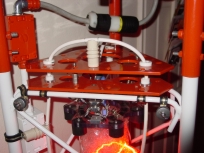
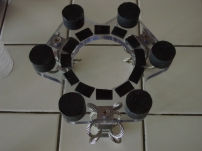 Crackle
Tube Holder
Crackle
Tube Holder This is my small contribution to this whole affair, making
a mounting scheme to hold the crackle tube inside the tower webbing.
Clamped to the webbing at each end of the central tower are powder coated CNC machined triangular aluminum
bulkhead plates.
Each plate supports a set of stainless steel cable isolators which in turn support two equally precision machined
1/2 inch thick clear Lexan crackle tube support plates. Between these
Lexan plates and the crackle tube there is a ring of 1/4" thick very soft, super vibration dampening Sorbothane
padding, which is itself surrounded by a set of cylindrical Sorbothane bumpers. All together this hardware holds the high value crackle tube gently but securely in
place. This provides very good protection from any externally applied abuse to the
tower, such as hammering. Hammering? Yes, the bolts that hold the beacon plates onto the tower truss
are interference fit. They need to be hammered in! It was really scary, but the isolators
work. 
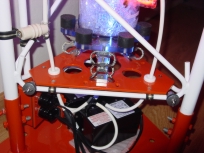 Ballistic
Shielding
Ballistic
ShieldingAre you setting your crackle tube up next to a pool table? The first time my kids uncovered our table it dawned on me that I needed additional armor to protect the crackle tube from flying pool balls, swinging cue sticks, or other potentially damaging missiles. This inspired the handsome expanded aluminum shielding shown to the right. This is held on with readily removable wing nuts and neoprene coated fender washers.
Alternatives to expanded metal shielding would be clear Lexan or drilled safety glass panels.
Visible running down the hollow center of the crackle tube is a blue 15 mm diameter lamp. It is supported by two glass standoffs, one on each Lexan end plate. Other colors for this center tube are available, covering the whole color spectrum from black light blue to warm white.
The neon transformers sit on the bottom plate. They plug into the duplex outlets on the bottom. These are Allanson size 7 indoor duty transformers with secondary ground fault protection (for enhanced fire safety it turns out, NOT for protecting people from shocks). One's 9 kV and the other's 7 kV. Haven't determined the strike voltages, but operating the blue tube averages a couple hundred volts, and the crackle tube averages around 700 volts.
To keep the high voltage return wires straight I ran them down through glass tubing supported by porcelain insulators. A little overkill but it looks nice. These stretches could also use a neon tube instead of wire for added glow.
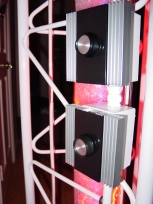
Two neon dimmers control the power to the outlets for the crackle tube and the blue tube transformers, allowing you to adjust the neon crackle / background blue ratio. These Diversified NE-15 dimmers are rated at 15 Amps each, way oversized for this application. But this reduces the risk of them burning out since they don't get hot and have really high surge current ratings. Plus, the large finned heat sinks look cool.
Neon dimmers differ from regular incandescent dimmers in that they are three wire devices, designed to handle the low power factor of un-power factor compensated neon transformers and having a snubber circuit to soak up inductive kicks from the transformer windings. The dimmers are mounted in the two white junction boxes in the middle of the tower, facing the wall.
Just sitting there the tower is pretty stable. However, being tall and narrow it is by nature top-heavy. To protect it and surrounding people (or equipment) from damage in the event of an earthquake, it needs to be tethered to a wall, bolted to the floor, or otherwise restrained. For tethering to a wall with electrical style, a pair of porcelain wireholders might be cool. But, shown in picture is a simple 3/4" web strap snap hooked to a 5/16" diameter eyebolt. The eyebolt must be screwed into a wall stud, not just into the wallboard. For bolting the thing to the floor could use four 5/8 lag bolts and concrete anchors. But should probably consult a mechanical engineer on strength of floor mounting since it's tall and has a big lever arm.
Yet another option (if you have a strong ceiling) is to hang the whole thing horizontally. With a couple extra down lights, you could have a really cool pool table light...
Radio towers using this truss system can be as tall as 300 feet, so they are very strong. At 70 pounds per normal 10 ft section (this crackle tube holder is a half sized 5 ft section), a 300 foot tall tower weighs a little over a ton. So you could use a set of these towers as columns to support a gazebo or pavilion, or to support bar glass or liquor racks, or to accent a bar. With a full 10 foot truss, the crackle tube can be attached between any three web sections, or you could put two crackle tubes in one truss.
On order, a chrome plated coin box. For the captive audience in airport terminals.
Created 26 April '03. Last updated 14 June 2003. Copyright © 2003 Kegmeter Electropneumatics, All rights reserved.